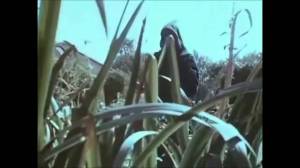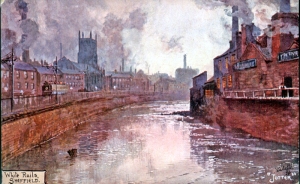Dr David Clarke of Sheffield Hallam University appeared on a BBC Radio 3 documentary about the River Don. In the Sheffield Telegraph he traces the myths and legends of the river as it flows through Sheffield:
One of my earliest memories is being told by my grandfather, an ex-steelworker at Ponds Forge, that Sheffield was founded on five rivers. And the most powerful of them all was the Don.
He knew the city’s most important industries – steelmaking, cutlery and, in his day, brewing – were dependent upon a plentiful supply of water. Streams supplied the rivers that flowed from the many hills that encircle the city.
Channelled through the valleys, like the fingers of a hand, the Don and the Porter, Rivelin, Loxley and Sheaf converge in the historic heart of Sheffield, at Castlegate. A clearing above the confluence of the Don and Sheaf gave its name to the earliest settlement, Sheaf-feld, where the castle was built. In medieval times the rivers also marked a boundary between the kingdoms of Northumbria and Mercia. No one knows when the Don was first bridged, but in the 12th century a small chapel, dedicated to ‘Our Lady Mary’, was founded below the castle walls. This became present-day Lady’s Bridge.
The power of the rivers and streams, harnessed during the industrial revolution, helped to make Sheffield’s steel industry world famous. In the Victorian era part of the Sheaf was channelled into a stone-built underground culvert to divert its floodwaters away from Pond hill. Today this massive storm drain, the Megatron, runs from Granville Square, under the station and Park Square, emerging to meet the Don near Blonk Street bridge.
For decades, a cocktail of deadly chemicals was pumped and poured into the river waters, leading the Don to be labelled as one of the most polluted stretches of water in Europe. Until 1928 animal blood from the slaughterhouses at The Shambles, on Castlegate added to the river’s filthy reputation. By the 1980s parts of the Don ran yellow and it was unable to sustain any kind of plant or animal life.
On occasions the Don and Sheaf have broken free, sometimes with deadly and destructive consequences. The ancient Lady’s Bridge survived the most recent flooding in 2007, when both rivers overflowed, but the Wicker and surrounding streets were submerged, sweeping a pedestrian to his death.

Part of the Megatron storm drain that runs beneath Sheffield City Centre (credit: Picture Sheffield)
In ancient times rivers were regarded as female and some believe the Don took its name from Danu, a Celtic goddess. The Romans built a fort, Danum, where it flows through present-day Doncaster and the name is also found in the river Danube. In folklore, you can never be certain about anything, but I’m sure that medieval travellers who crossed the Don at Lady’s Bridge would not want to take any chances. Perhaps this explains the instinctive urge to throw coins and other precious objects ‘for luck’ into pools and springs.

A still from the eerie 1973 public information film, The Spirit of Dark and Lonely Waters,. The voice over is provided by Donald Pleasance (credit: YouTube)
This custom persists into the present day. Guitarist Russell Senior, of Pulp, recalls how he and Jarvis Cocker, as teenagers, cast coins into the river near the Wicker to appease ‘the spirit of dark and lonely water’. This was no ghost, but an imaginary Bergmanesque figure, in a monk’s robe, who appears in a scary 1973 public information film that warned children to stay away from riverbanks.
There is more evidence of Cocker’s interest in the Don and its folklore in the lyrics of Pulp’s song Wickerman (2001):
‘… we gazed down at the sludgy brown surface of the water together.
Then a passer-by told us that it used to be a local custom to jump off the viaduct into the river
When coming home from the pub on a Saturday night. But that this custom had died out when someone jumped
Landed too near to the riverbank
Had sunk in the mud there & drowned before anyone could reach them.’
The Don’s dangerous reputation can be traced back to the middle ages when Sheffielders referred to it as the Dun, rhyming with the word son. Dun is also an old English word for dark and the historian Joseph Hunter recorded a sinister old phrase, popular in the 18th century:
The shelving, slimy river Dun
Each year a daughter or a son
Hunter thought this might point to a time when sacrifices, animal or even human, were offered to water spirits.
Many rivers were once believed to demand a quota of victims. The Dart in Devonshire and the Ure in Yorkshire took one life each year. The Ribble in Lancashire was happy with a sacrifice every seventh year, but could be appeased by the offering of a small bird or animal.
Thankfully today’s river Don is anything but sinister. Its reputation as a ‘horrible, sludgy, dirty and smelly’ stretch of water is long gone. Heron and otter have returned to its banks and last year plans were announced to reintroduce salmon.
As David Bramwell says, in his radio programme, ‘the wrongs committed to Danu by Vulcan, the harsh overlord of the steel industry, in the name of progress and industrialisation’ are now a thing of the past.
BBC Radio 3 Between the Ears: Danu – Dead Flows the Don is available on Listen Again.
Learn more about Castlegate and plans for the excavation of the ruins at Friends of Sheffield Castle


Pingback: The Dark Side of Sheffield Folklore: Spectres and River Spirits - Icy Sedgwick